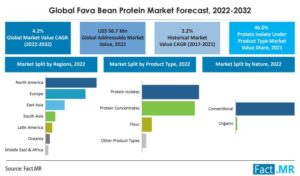In recent years, the global market for plant-based protein sources has witnessed remarkable growth, driven by increasing consumer demand for sustainable and nutritious alternatives to animal-derived proteins. Fava bean protein, derived from the versatile and protein-rich fava bean (Vicia faba), has emerged as a promising player in this evolving landscape. This article provides a comprehensive market research analysis of the fava bean protein market, exploring the key growth drivers, current trends, and potential future prospects for this innovative protein source.
For More insights into the, Request a Sample of this Report:
Key Growth Drivers for the Fava Bean Protein Market:
Rising Demand for Plant-Based Proteins: Growing awareness of environmental sustainability, ethical considerations, and health benefits has spurred the demand for plant-based protein sources, including fava bean protein.
Nutritional Profile: Fava beans are rich in protein, dietary fiber, essential amino acids, and minerals, making fava bean protein an attractive option for consumers seeking nutrient-dense alternatives.
Allergen-Free and Non-GMO: Fava bean protein is naturally free from common allergens such as soy and dairy. Moreover, its non-genetically modified (GMO) nature appeals to consumers seeking clean and minimally processed ingredients.
Functional Properties: Fava bean protein’s functional properties, such as emulsification, gelling, and foaming, make it a versatile ingredient for various food and beverage applications.
Current Trends in the Fava Bean Protein Market:
Product Diversification: Manufacturers are developing a wide range of fava bean protein products, including powders, concentrates, isolates, and protein-rich snacks, to cater to diverse consumer preferences and usage scenarios.
Innovative Food Applications: Fava bean protein is being incorporated into various food products, including meat alternatives, dairy-free yogurts, bakery items, and nutritional supplements, contributing to the expansion of its market footprint.
Clean Label and Transparency: Consumers are demanding transparency in ingredient sourcing and production methods. Brands that prioritize clean labeling and sustainable sourcing are likely to gain a competitive edge.
Emerging Global Markets: The adoption of plant-based diets is spreading beyond traditional markets, leading to increasing demand for fava bean protein in regions such as Asia-Pacific and Latin America.
Future Outlook and Growth Opportunities:
Research and Development: Continued investment in research and development is essential to optimize fava bean protein’s taste, texture, and functional properties, ensuring its successful integration into a wide range of food products.
Partnerships and Collaborations: Collaboration between food manufacturers, ingredient suppliers, and research institutions can drive innovation and facilitate the development of novel fava bean protein-based products.
Consumer Education: Educating consumers about the nutritional benefits and sustainable aspects of fava bean protein can contribute to increased market adoption and consumer loyalty.
Regulatory Landscape: Monitoring and adapting to evolving regulations related to labeling, health claims, and ingredient standards will be crucial for sustained market growth.
The fava bean protein market is poised for significant expansion as the demand for plant-based proteins continues to rise. With its impressive nutritional profile, functional versatility, and allergen-free nature, fava bean protein holds great potential as a staple ingredient in various food and beverage applications.
